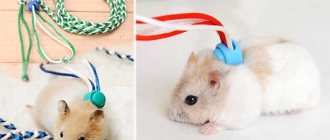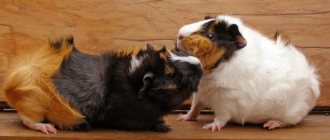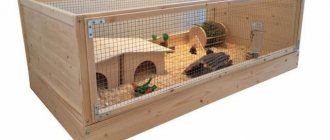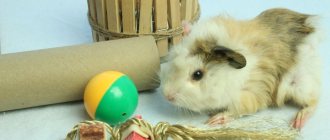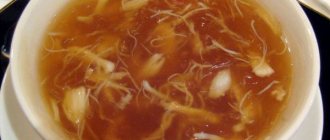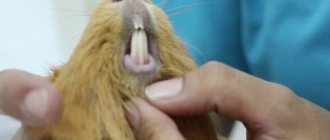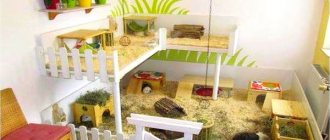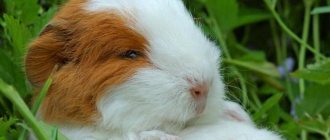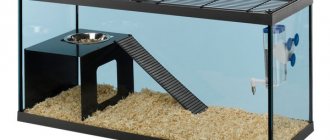Coronet is a guinea pig obtained through careful selection and crossing. Several decades ago, an Englishwoman named Claire White, who breeds guinea pigs, decided to breed a new breed of these animals. As parents, she chose representatives of short-haired and long-haired breeds - English Crested and Sheltie, respectively. As you know, the “highlight” of Crested rodents is the hair on the head, growing in a rosette. As a result of the selection, a breed of long-haired pigs with a woolen crown on their heads was born, which received the characteristic name Coronet.
Description
Coronet pigs are very beautiful. The main characteristic feature of the appearance of this long-haired animal is that the hair on the pig’s head is naturally arranged in a kind of rosette crown. The body's fur is thick. Forming a parting on the back, long hairs fall from the sides of the animal and create a kind of train. Coronet wool is characterized by:
- softness;
- smoothness;
- silkiness.
A woolen crown is placed on top of the head. The less visible the center of the rosette, the more elite the animal is considered. For the crown, symmetry and integrity are important - the structure should not fall apart. The best shape for a rosette is considered to be something like a deep bowl.
In terms of possible color options, these rodents are distinguished by their diversity. You can meet animals of this breed:
- plain;
- two-color;
- tricolor;
- spotted.
The physique of adult animals is dense and proportional, at least 20 cm long. From above, the body of the fluffy animal is shaped like a pear or a teardrop. Adult animals weigh 0.8-1 kg, but there are also record holders weighing more than 1 kg (their body length exceeds 30 cm).
The head is large, and the effectiveness of the rosette crown depends on its dimensions (the wider and larger, the better). The nose is short, the eyes are bulging. The ears are quite large in size, with the tips down and pointed forward.
Reviews
Most owners speak positively about keeping their pets. These animals are able to please not only with their charming appearance, reminiscent of imperious royalty, but also with their quiet character. The only difficulty is acquiring purebred individuals; many breeders have a schedule for selling cubs months in advance. Most sellers immediately describe the nuances of care, focusing on the wool. Many are attracted not only by the chic curls of coronets, but also by the variety of colors. Tri-colored, spotted pigs have gained particular popularity. A common combination is white, red and black. Some owners even come up with hairstyles for their pets, but you shouldn’t get carried away with this idea.
Where to buy a purebred pig and how much
Today, purchasing a real thoroughbred Coronet is possible only through private breeders. This species is still considered quite young, therefore it is not yet as widespread as older breeds (selfie, sheltie and others).
The cost of a rodent is influenced by the degree to which each individual animal corresponds to the characteristic characteristics of the breed. The minimum price for a Coronet guinea pig with a pedigree is two thousand rubles. An animal with great breeding value and an exhibition career will cost at least five or even six thousand rubles.
How to find out the breed of a baby guinea pig
• Most of the listed breeds are born with a characteristic fluffy appearance and open eyes.
Therefore, the description of the breeds is suitable for small cubs. • Lunkaria cubs can be identified by their coarse, curly coat, which softens with age. • At the time of gaining independence, small long-haired piglets already have hair 2-3 centimeters long, which is longer than that of ordinary piglets. • Questions may arise when choosing a baby bald. If in front of you is a month-old cub and it is almost completely hairless, except for the nose and paws, then you have Skinny in front of you. Baldyki remain fluffy for up to a month, maximum two. Next, they shed their fur, starting from the head. There is a risk of getting caught by a Baldwin mixed breed with a woolly pig. Such representatives have such good health, but not a very aesthetic appearance - there may be areas of skin covered with sparse long hair. There is no need to worry if you have the opportunity to adopt a one-year-old animal, because the life expectancy of guinea pigs at home is about 8 years, and you can meet centenarians 10 years and older. Guinea pig, guinea pig breeds
Behavior and character
These rodents are similar in character to representatives of other breeds. They are characterized by curiosity and peacefulness. Many Coronets are quite vain and crave attention and praise. This is understandable - nature has endowed them with such an attractive appearance that they a priori cannot help but be the center of attention.
At exhibitions, coronets feel, as they say, “at ease” - this is their element. At such events, pigs are exhibited on special stands so that the public can see the animals in all their glory. The coronet behaves calmly, freezes on the stands and allows the experts to carefully examine themselves. In all the poses, movements and expressions of the faces of these fluffies, one can read such royal grandeur, which not every real king can boast of. They are created to be adored and praised.
Care and maintenance of coronet
Caring for Coronets is not much different from caring for other breeds of pigs. Only because of their long hair do they require daily inspection. This fact must be taken into account before you decide to get such a pig or want to start breeding. The most important requirement is more time. If proper care is not given, their hair will become tangled and this will be unpleasant for both the pig and the owner.
Curls are most often used to care for the coat of show-class pigs.
Here is what the famous Coronet breeder Dorothy Wilson, Cherished Cavies nursery, writes about care:
“I spend a lot of time caring for my pigs every day.
They live in small groups of two to four in very large cages that I keep in the basement. In each cage the pigs have a lot of toys so they don’t get bored and a lot of houses so they have a place to sleep. Every night I spend about an hour getting everyone water and fresh vegetables. When I'm downstairs (in the basement), I pick out a few pigs and take them to my bedroom to get them ready for showing. Cleaning the cages takes 8 hours a week, after all the cages are cleaned I begin to examine each pig. I trim the claws and sort out the tangles in the fur. Those pigs that are in the bedroom are very carefully examined every two days, the wool is groomed and kept in curlers.
And when the pig's show career ends, the train is cut for the pig's comfort.
It takes a huge amount of time, but I enjoy the time I spend with the pigs."
Coronet, like other guinea pigs, is only suitable for indoor keeping; such pets cannot live outside. They can (and should!) be let out for a walk during the warm season. And in winter, a walk around the room will be enough. Guinea pigs need a lot of exercise and love to play and explore the world around them.
Conditions of detention
The lifespan of Coronets is slightly shorter than most short-haired rodents, at approximately 6–8 years. In order for the animal to live long and happily, you need to properly care for it. The requirements for the care and maintenance of the Coronet do not differ from the conditions necessary for other long-haired breeds.
For a comfortable living of a furry animal, a cage house with a size of at least 100x60 cm is required. There must be enough free space in the coronet’s home so that he can move freely or lay out his luxurious fur coat.
Diet
The coronet menu must include:
- grass and hay;
- grain mixtures;
- fresh vegetables and fruits.
To maintain the beauty of the coat, it is recommended to include legumes and sunflower seeds in the diet. They are saturated with fats and vitamins, which will have a beneficial effect on the quality of the pig's coat. If an animal suddenly starts nibbling on its own or a neighbor’s hair, you need to include mineral and vitamin supplements in its menu.
The list of foods that are prohibited for giving to coronet pigs contains the same products that are prohibited for other pigs. It includes:
- tops of nightshade plants;
- boiled porridge;
- foods that contribute to excessive gas formation and bloating.
Fur coat care
To prevent the Coronet's luxurious fur from becoming tangled, the young animal needs to be brushed every day. To do this, you will need the simplest set of equipment - a soft brush and several different combs.
The older the animal gets, the more its fur becomes coarser. Thanks to this, it becomes less and less tangled. You can comb your fur coat a little less often. But at the same time, the need for regular frequent inspections of the coat does not disappear. To protect the hairs from various damages, you can twist the fur into curling irons, after dividing it into strands.
Animals participating in exhibitions require professional care. At the preparatory stage before the performance, you should use the services of a specialist or contact an experienced breeder. If a Coronet pig does not participate in exhibitions, but is simply kept as a pet, it is worth giving it special hygienic haircuts (especially in the hot summer season).
To ensure that caring for a pig is not complicated, the animal must be accustomed to all the necessary procedures and processes from childhood:
- combing;
- washing;
- haircut;
- blow drying, etc.
These long-haired animals are not suitable as pets for those who cannot devote 1-2 hours every day to caring for a pig. In addition, you should not give a coronet to small children or preschoolers. It is best to buy a pig as a gift when the child goes to school, becomes quite independent and can properly care for the pet.
Guinea pigs with long hair
Peruvian
Peruvians are the pioneers of these cute, long-haired animals. Selection for their breeding began already in the 1800s in Europe. The long, thin fur of pets falls on the sides and on the head. Therefore, if the pig is not a show pig, the “bangs” can be trimmed, otherwise they can be tied up or pinned. Breed standards require only a straight coat, without curls, and two rosettes - on the rump and head, near the nose. Their character is much calmer than that of other representatives; they can sit on their hands for a long time.
Sheltie and Coronet
Shelties can rightfully be considered the most pleasant to the touch. Compared to the Peruvian, the silky representatives do not have a parting on the back, the fur falls back. True shelties should not have any rosettes, and the covering on the head is much thicker, creating a kind of mane. Like many long-haired guinea pigs, they also have a calm temperament. But Coronets are rightfully the most active among the longhaired ones. They are distinguished by a single rosette on the head, the glossy long fur from which falls beautifully on the sides without covering the face. Pets that do not participate in exhibitions are usually cut into a bob so that the coat does not become dirty. It took much longer to produce modern Coronets than the breeds described above. To understand for yourself which guinea pig is the best of the breeds with such a hairstyle, you should pay attention to the character. The most peaceful and slow are Peruvians and Shelties, the most active and playful are Coronet. But the latter can also sometimes be in a phlegmatic mood.
On the left - Peruvian, in the middle - Sheltie, on the right - Coronet
Breeding
Animals of breeding value are allowed to reproduce immediately upon reaching maturity. The best age for first mating is:
- 6–8 months for females;
- 10–12 months for males.
The best of the best representatives are used to breed Coronet. This is a necessary condition for breeding offspring with characteristics and parameters that improve the livestock. You can find a good partner for your pig in a specialized club for Coronet guinea pig lovers.
The fluffiest of fluffies
Rex
Rex is considered one of the newly developed breeds. They should not have rosettes; the hair on the head is usually coarser than on the back and sides. Due to the nature of the Rex guinea pig's coat, they sometimes need to be brushed with a special brush. Interestingly, this is one of the most intelligent breeds that can be trained. They need the company of their relatives more than others.
American Teddy
This breed is also one of the fluffiest and largest. They can be identified by their drooping ears and predominantly coarse coat.
The thickest wool is Alpaca
The Alpaca breed has a very thick, long, curly coat. They were bred back in the 19th century in South America. The main external differences are that there are several rosettes on the muzzle and the back of the body, and the growth of the cover on the legs from bottom to top. Alpacas are very friendly even towards strangers and have a calm character.
Left - Rex, middle - Teddy, right - Alpaca
Coronet cage
Every guinea pig needs a home. Most often this is a cell. The main requirement for a cage is space. Guinea pigs are quite active and mobile animals; they vitally need to move a lot. The minimum allowable area of a cage for a guinea pig is 0.6 square meters, which corresponds to a size of 100x60 cm. All those cages that are smaller in size are not suitable for guinea pigs. Of course, you can put your pet in a smaller cage, but in this case you need to be prepared for possible future problems with the health and character of the guinea pig.
Read about what a cage should be like in the article “Cage for a Guinea Pig”
Alpaca
| Origin | Peru |
| Dimensions | height – 20-30 cm, weight – up to 1.3 kg |
| Character | melancholy |
| Usage | pet |
| Lifespan | up to 7 years with good care |
Alpaca pigs got their name from an animal that belongs to the llama family. The Alpaca guinea pig is more similar to the rodent from Peru, however, with the naked eye one can easily confuse it with other representatives of this genus. The fur also grows towards the head, and two rosettes can be found on the rump.
The coat is quite soft, and if you comb it daily, over time it will only take on a more pleasant appearance. The color of its coat can vary in different color directions. An alpaca can be one color, or it can have two or even three different colors on its body. They are also distinguished by an overly calm disposition; they love tenderness, affection, warmth and sleep.
